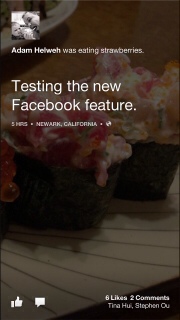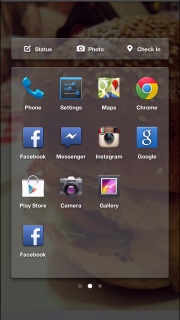If you attended Facebook’s “our new Home on Android” event last Thursday — or watched the live stream — you could be forgiven if you came away confused about just how significant Facebook thought its news was.
On one hand, Facebook CEO Mark Zuckerberg kept stressing that, despite long-standing rumors, the company wasn’t announcing a “Facebook phone” after all. Nor had it created a Facebook phone operating system. Its new product, Facebook Home, was just a replacement for Android’s standard home screen; one that was shipping on just one new phone — HTC’s First — and which could be installed on a few different existing phone models from Samsung and HTC.
But Zuckerberg also said Facebook Home was a paradigm shift: a piece of software that makes the phones running it people-centric rather than app-centric. And he called it the best version of Facebook yet — not just for phones, but for any sort of device.
So which is it? Is Facebook Home a simple and straightforward piece of software, or a landmark?
Well, conceptually, it’s indeed a big deal: allowing one social network to insert itself, front and center, into your smartphone experience could change everything about how you interact with your phone.
But the thing is, there just isn’t that much Facebook Home to interact with. There are pretty pictures from your news feed, updates from your friends and an exceptionally clever messaging feature called Chat Heads — and not a whole lot else. To riff on what Gertrude Stein said about her hometown of Oakland, Calif., there’s not much there there.
Not yet, anyhow. But Zuckerberg said Facebook plans to release monthly updates to Home, which means that it could get much meatier in a hurry. And even though the software isn’t fancy, it represents Facebook’s first full-blown attempt to reimagine itself for a more mobile world. (The standard Facebook smartphone apps are pretty much just conventional Facebook, crammed onto a smaller display.) As such, it’s the company’s first rough draft of its own future.
I tried Facebook Home on HTC’s First, which will go on sale on April 12, the same day that the Home download becomes available to other phones. The LTE phone will be an AT&T exclusive, for $99.99 with a two-year contract. As the relatively low price indicates, it’s a basic smartphone, not a Galaxy S4 killer: the 4.3-in. (10.9 cm) screen is small by Android standards, the camera has only 5 megapixels of resolution and the Qualcomm processor isn’t among the most potent.
I found it to be a pleasing piece of hardware anyhow — a handset with a pocketable, one-hand feel similar to the iPhone 5 and a sleek, minimalist industrial design. It’s in line with the Facebook Home idea, which emphasizes simplicity over kitchen-sink complexity.
O.K., on to Home itself. It replaces Android’s standard lock screen and home screen with Cover Feed, a feature that reminds me a bit of browsing Facebook in Flipboard. It displays status updates and photos from your friends, one full-screen item at a time. You can swipe your way through them, letting you catch up on what your pals are doing within milliseconds of turning on your phone.
(You can also choose to use Home as your home screen but disable it in the lock screen. You might want to do that if you’d prefer to have one photo you choose greet you when you switch on your phone, rather than a fresh, ever-changing selection of items from Facebook.)
Cover Feed is constantly downloading updates and photos in the background — though it’s careful about doing so in a way that won’t kill your battery or decimate your data plan — so that they’re just there when you’re ready to look at them. You never have to pause while additional items load, as you do with Facebook’s standard app.
There’s a basic problem with blowing up Facebook photos to fill a phone’s whole screen, though: phone screens are designed to be used primarily in portrait orientation. (In fact, that’s the only orientation that Home supports.) Photos, by contrast, are most often landscape-shaped. Home deals with this by panning majestically across photos, Ken Burns style — which sometimes works quite well and sometimes renders them illegible. You can also press and hold a photo to see it in a smaller-but-complete view.
Cover Feed, like Facebook’s News Feed, is a never-ending river of stuff from all your friends. If a friend uses Facebook to aim something directly at you, by posting on your wall or sending you a message, it’ll show up as a banner notification on the lock screen, roughly comparable to the ones in Apple’s iOS. These notifications also alert you to new e-mail, calendar appointments and other items, and are cleaner and easier to read than the ones in standard Android. Nicely done.
The single best thing in this first version of Facebook Home, however, is Chat Heads. (I even admire the wonderfully silly name.) When you get an incoming Facebook message or a text message, a marblelike circle — a Chat Head — pops up on top of whatever else you’re doing on your phone. You can swipe the Chat Head to nudge it to any location on the screen, or tap it to begin chatting in a pop-up window. And you talk with multiple Chat Heads at one time. Much more efficient than hopping back and forth between two apps.
(The one thing that sometimes flummoxed me: each Chat Head is a tiny version of the person’s profile picture, cropped to fit inside a circle. I couldn’t always tell whom a Chat Head represented from this visual clue alone. Oh, and for reasons I don’t understand, Chat Heads are only initiated by an incoming message from a friend — if you start the conversation, you do so in the standard Facebook Messenger app.)
Despite Zuckerberg’s stance at the Facebook Home launch event that the software is organized around people, not apps, you’re going to spend plenty of time on a Facebook Home phone using apps — Facebook’s standard app and Facebook Messenger; all of Google’s built-in Android apps, such as Gmail and Chrome; and third-party apps you’ve installed. You get to them using Home’s launcher, which is comparable in overarching principle to the standard Android launcher and other third-party alternatives. As usual, there’s a section for your favorite apps and one that lists all your apps. (You press and hold an app to add it to the favorites.)
The launcher also lets you post status updates, upload photos and check in, putting three of Facebook’s most important features at your, um, fingertip.
It doesn’t, however, allow you to do a few things you might assume it would. For instance, you can’t drag multiple apps onto each other to organize them into space-saving groups, as you can with stock Android. Widgets — the little applets that sit right on the home screen, providing one of Android’s most striking advantages over Apple’s iOS — don’t work. Clearly, Facebook Home isn’t aimed at Android power users.
Oddly enough, it also doesn’t seem to be designed for Facebook power users. Its two major Facebook-related features — Cover Feed and Chat Heads — address only a tiny percentage of the full service’s super-long laundry list of features. You can’t peruse photo albums, view videos, visit groups, check out events or see most of the things your friends are doing on third-party services that support Facebook’s Open Graph integration. You can’t even browse the timeline of a particular friend. Or, for that matter, your own timeline.
Or to be more specific: you can do all those things. But you do them in the conventional Facebook app, just as you would on a phone that didn’t have Facebook Home installed at all.
Really, if what you want is a people-centric phone, you should consider one that uses Windows Phone 8. Microsoft’s phone operating system is a much more fleshed-out exploration of the vision Zuckerberg articulated at the Home launch event; it’s even used a phrase Zuck mentioned — “put people first” — as its tagline.
I think I know what Facebook is up to here. Rather than releasing a piece of software that tried to do everything from the get-go — which is usually a recipe for not doing anything particularly well — it decided to make this first version of Home basic, but good. And for the most part, it succeeded. Home is polished, fluid and fun — significant achievements considering that it’s a type of app Facebook has never tackled before.
By getting a minimalist version of the Facebook Home concept out there and promoting it heavily, the company is establishing a beachhead on Android home screens. By the time it has a do-everything version of Home that incorporates ads, millions of consumers may have already turned their home screens into Facebook Home screens.
Should you be one of the earliest adopters? If you like Facebook and have a phone that will work with Facebook Home, trying the software is a risk-free proposition; you’ll probably be able to tell within minutes whether this first version speaks to you. If it doesn’t, you can delete it (or leave it installed in stand-alone app form, so it’s available but doesn’t take over your home and lock screen).
This is Facebook we’re talking about, though, and if the company takes Home as seriously as it seems to be doing, the software will be subject to ongoing revision, reinterpretation and reinvention. So if you find Zuckerberg’s grandiose vision appealing rather than scary or off-putting, just wait: a future Facebook Home might live up to it in ways that this first version does not.




![[image] Facebook Home Notifications](http://techland.time.com/wp-content/uploads/sites/15/2013/04/wpid-photo-apr-9-2013-520-am3.jpg)
![[image] Facebook Home Chat Heads](http://techland.time.com/wp-content/uploads/sites/15/2013/04/wpid-photo-apr-9-2013-520-am2.jpg)
